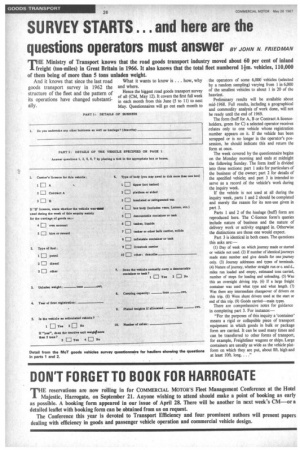SURVEY STARTS ... and here are the
Page 28

If you've noticed an error in this article please click here to report it so we can fix it.
questions operators must answer BY JOHN N FRIEDMAN Ministry of Transport knows that the road goods transport industry moved about 60 per cent of inland freight (ton-miles) in Great Britain in 1966. It also knows that the total fleet numbered 1-1-m. vehicles, 110,000 of them being of more than 5 tons unladen weight.
And it knows that since the last road goods transport survey in 1962 the structure of the fleet and the pattern of its operations have changed substantially.
What it wants to know is . how, why and where.
Hence the biggest road goods transport survey of all (CM, May 12). It covers the first full week in each month from this June (5 to 11) to next May. Questionnaires will go out each month to the operators of some 6,000 vehicles (selected by a random sampling) varying from 1 in 6,000 of the smallest vehicles to about 1 in 20 of the heaviest.
Preliminary results will be available about mid-1968. Full results, including a geographical and commodity analysis of work done, will not be ready until the end of 1969.
The form (buff for A, B or Contract A licenceholders, green for C) a selected operator receives relates only to one vehicle whose registration number appears on it. If the vehicle has been scrapped or is no longer in the operator's possession, he should indicate this and return the form at once.
The week covered by the questionnaire begins on the Monday morning and ends at midnight the following Sunday. The form itself is divided into three sections: part 1 asks for particulars of the business of the owner; part 2 for details of the specified vehicle; and part 3 is intended to serve as a record of the vehicle's work during the inquiry week.
If the vehicle is not used at all during the inquiry week, parts 1 and 2 should be completed and merely the reason for its non-use given in part 3.
Parts 1 and 2 of the haulage (bull) form are reproduced here. The C-licence form's queries include nature of business and the nature of delivery work or activity engaged in. Otherwise the distinctions are those one would expect.
Part 3 is identical in both cases. The questions this asks are:— (I) Day of week on which journey made or started or vehicle not used. (2) If number of identical journeys made state number and give details for one journey only. (3) Journey addresses and types of terminals. (4) Nature of journey, whether straight run or c. and d., miles run loaded and empty, estimated tons carried, number of stops for loading and unloading. (5) Was this an overnight driving trip. (6) If a large freight container was used what type and what length. (7) Was there any intermediate changeover of drivers on this trip. (8) Were shunt drivers used at the start or end of this trip. (9) Goods carried—main types.
There are comprehensive notes for guidance in completing part 3. For instance:—
"For the purposes of this inquiry a 'container' means a rigid or collapsible piece of transport equipment in which goods in bulk or package form are carried. It can be used many times and can be transferred to other forms of transport, for example, Freightliner wagons or ships. Large containers are usually as wide as the vehicle platform on which they are put, about 8ft. high and at least 10ft. long.. . ."












































































































